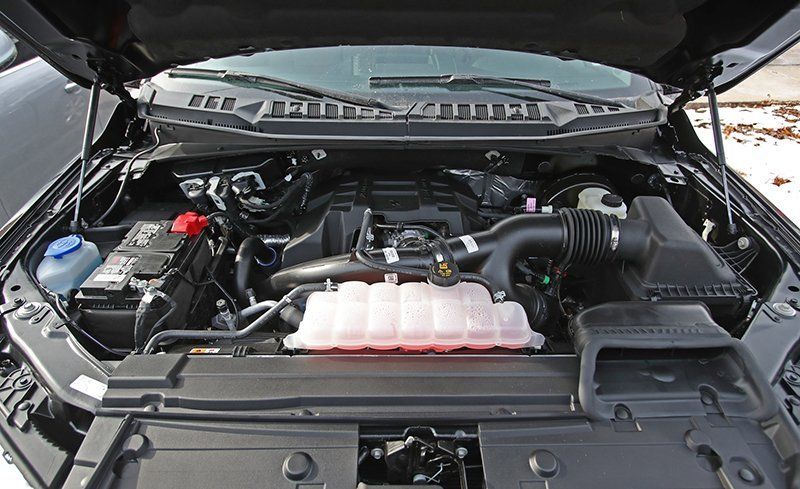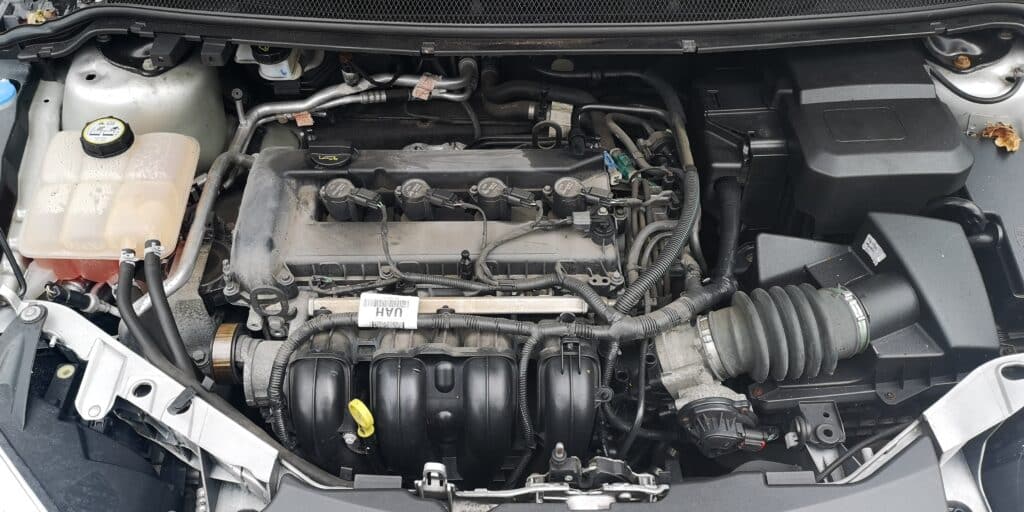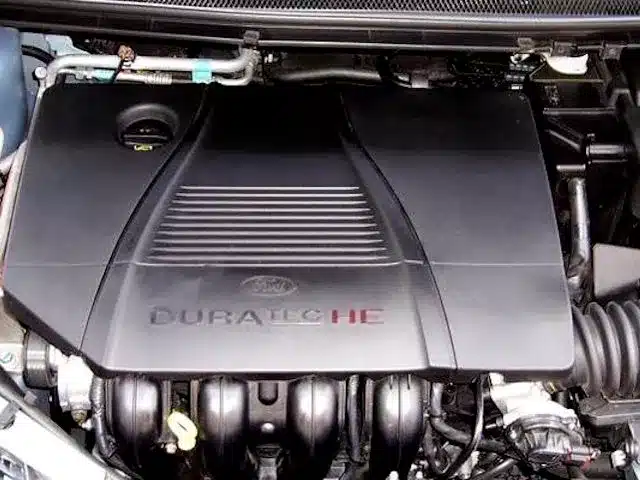The EcoBoost 3.5L is a V6 twin-turbocharged engine from Ford Motor that has been powering midsize and full-size cars, pickup trucks, supercars, and utility vehicles or more commonly known as SUVs, since 2010. The EcoBoost 3.5L relies on a DOHC (dual overhead cam) design with the V configuration to keep consumers safe and comfortable during the first experience of driving an SUV.
This engine was first seen in the 2010 Lincoln MKS and is heavily derived from the Ford Duratec 35 V6 engine block. It has many characteristics similar to Ford turbine engines, for example, 15,000 rpm with a maximum boost of 17 psi when used as an automotive truck vehicle.
This engine’s versatility makes it a top choice among those who love driving because it works for many different vehicles.
3.5 EcoBoost Specs
| Manufacturer | Cleveland Engine Plant No. 1, Ohio, USA |
| Production years | 2009-present |
| Cylinder block material | Cast Aluminum |
| Cylinder head material | Aluminum |
| Camshaft drive | Chain |
| Engine family | EcoBoost |
| Displacement | 3.5 liter |
| Aspiration | Twin-turbo |
| Configuration & cylinders | V configuration, six cylinders |
| Vehicle engine orientation | Transverse/longitudinal |
| Fuel type | Gasoline |
| Valve configuration | Dual overhead cam (DOHC) with variable camshaft timing (VCT) |
| Predecessor | Ford Duratec 35 V6 |
| Bore | 92.5 mm |
| Stroke | 86.6 mm |
| Compression ratio (2011 – 2016) | 10.0:1 |
| Compression ration (2017 +) | 10.5:1 |
| Max power @ RPM | 647 @ 6,250 rpm |
| Max torque @ RPM | 630 lb-pi @ 5,900 rpm |
| Firing order | 1-4-2-5-3-6 |
| Engine weight | – |
| Oil change interval, mile | 9,000 (15,000 km) / 12 months |
| Part | Capacity |
|---|---|
| Engine oil (with oil filter) | 6.0 qt (5.7 L) |
| Engine coolant | 13.1 qt (12.4 L) |
| Brake fluid | Between MIN/MAX on brake fluid reservoir |
| Rear axle fluid (four-wheel drive) | 2.11 pt (1.0 L) |
| Automatic transmission fluid (6F50) | 10.9 qt (10.3 L)1 |
| Automatic transmission fluid (6F55) | 11.6 qt (11 L)1 |
| Power Transfer Unit (PTU) fluid (four-wheel drive) | 17.9 fl oz (0.53 L) |
| Windshield washer fluid | Fill as required |
| Fuel tank | 18.6 gal (70.4 L) |
| A/C refrigerant | 2.8 lb (1.28 kg) |
| A/C refrigerant compressor oil | 7.3 fl oz (215 ml) |
3.5 EcoBoost Engine Oil Capacity
The 3.5l EcoBoost engine requires 6 US Quarts (5.7 Liters) of new SAE 5W-30 oil for an oil change with a new oil filter.
1st Gen 3.5L EcoBoost
The first-generation Ford 3.5L EcoBoost engine, while performing admirably in its own right, was crippled by the technology available at the time, leading to some minor design flaws that will be discussed later.
The first generation of the EcoBoost engine was capable of 355-380 horsepower, depending on what vehicle it is found in. The smaller twin turbos quickly spool and provide lots of low-end torque, which makes the 3.5L EB perfect for towing and daily driving without lugging your engine at high RPMs.
- 2010-2019 Ford Flex
- 2010-2016 Lincoln MKS
- 2010-2019 Lincoln MKT
- 2010-2019 Ford Taurus SHO
- 2013-2019 Ford Explorer Sport & Platinum
- 2011-2016 Ford F-150
- 2015-2017 Ford Expedition
- 2015-2017 Lincoln Navigator
2nd Gen 3.5 V6 EcoBoost
Ford released a new EcoBoost engine in 2017 for some models. This model features an increase in horsepower, except the 647hp variant which remains unchanged. The difference is that this engine has more power than the standard 3.5 unit found on most other cars supported by EcoBoost technology and provides a competitive edge to what would otherwise be
In addition to port injection, the 2nd generation 3.5L EcoBoost Engine also has several other changes from the 1st gen engine that we’ll discuss below. Additionally, Ford redesigned the timing chain for better reliability and eliminated many design flaws seen in 1st gen engines.
- 2017-present Ford F-150
- 2018-present Ford Expedition
- 2017-present Ford F-150 Raptor
- 2018-present Lincoln Navigator
- 2017-present Ford GT
What Are The Horsepower And Torque Of The Ford 3.5 EcoBoost Engine?
- Lincoln MKS: 365 HP at 5,500 RPM and torque of 350 lb-ft. at 1,500 RPM
- Lincoln MKT: 365 HP at 5,700 RPM and torque of 350 lb-ft. at 1,500-5250 RPM
- Ford Taurus SHO: 365 HP at 5,500 RPM and torque of 350 lb-ft. at 3,500 RPM
- Ford Explorer Sport & Platinum: 365 HP at 5,700 RPM and torque of 350 lb-ft. at 3,500 RPM
- Ford F-150: 290 HP at 6,500 RPM and torque of 265 lb-ft. at 4,000 RPM
Ford 3.5 EcoBoost Engine Problems And Reliability
The pros and cons of the Ford 3.5L EcoBoost engine are many but can be narrowed down to a few common items that people experience, including:
Intake Valve Carbon Build-Up
The oil and carbon buildup on the intake valves is a consequence of how direct injection engines work. Direct injection means fuel is sprayed directly at the engine’s cylinders, which causes the build-up over time. In port-injected engines, fuel is delivered through tubes branching from near the top of each cylinder head instead of down at its base.
Some DI engines have major issues with carbon buildup and require valve cleaning often, which is not a good thing. Power loss may result from the lack of air flow.
Ford’s second-generation 3.5L EcoBoost engine, by combining these features to overcome the disadvantages of one or the other, has succeeded in making this generation an even better option for consumers than its predecessor.
Excess Carbon Build-Up Symptoms:
- Misfires
- Rough idle
- Stuttering/hesitation
- Power loss
The 3.5L EcoBoost engine will misfire if there is carbon buildup on the cylinder wall. Carbon buildup can cause a variety of symptoms directly and indirectly, including fault codes, rough idle or stuttering, power loss and difficulty starting the vehicle.
Carbon Build-up “Fix”
You want to consider walnut blasting the intake ports, as these can become clogged with carbon deposits. Removing this material is best done by using a shop vac and abrasive media shells. Otherwise, you’ll usually just need access to the ports which often means they have to be dismantled first. Walnut blast intake cleaning service costs around
Ford 3.5L EcoBoost Engine can make an owner’s life significantly easier, especially because maintaining it just takes a few minutes every so often without the need for urgent attention. However, if you’d rather take your chances with the chance of having major engine problems in the future and only occasionally taking care of carbon deposits on the engine by spraying them.
EcoBoost Timing Chain Problems
In the face of such potential engine issues, it is imperative to keep an engine’s oil and fluids in top condition. If you fail to do so, serious problems could arise.
Timing chain issues are typically reserved for the 1st generation Ford 3.5L EcoBoost engines built between 2010-2014, but it is possible that they are only linked to F-150 models because of their popularity in those vehicles.
Despite this rumor, Ford did engineer a better timing chain system for the 2nd generation 3.5L
The 3.5L EcoBoost from Ford has some potential issues with the timing chain and guides. If you’re out of warranty, Ford will work with you to help rectify the problem.
The timing chain on the 3.5L EcoBoost engine can be an especially expensive part, but it is a necessary repair for any owner to keep in mind.
Timing Chain Symptoms:
If you experience problems with your 3.5 EcoBoost engine, there are a few symptoms to notice such as:
- Cold start rattle
- DTC P0016
- Check engine light
- Drivability issues
Rattle on cold blocks can be caused by the timing chain, but plenty of other issues will trigger this symptom. Ford’s 3.5L EcoBoost engine throws P0016 as a fault code and will cause the check engine light to come on if there is an issue with the timing chain.
Intercooler Condensation Problem
F-150 models with 3.5L EcoBoost engines sometimes have issues with water being trapped (vs. vaporized) in the intercooler, due to a design flaw that does not allow water to be quickly vaporized in high humidity conditions. Ford redesigned this part, later on, to avoid adding demand on what parts are susceptible and difficult to dry.
Ford 3.5 V6 Spark Plug & Ignition Coil Issues
The 3.5 EcoBoost engine also has a history of spark plugs and ignition coils going bad. The high cylinder pressures from the turbos can put a lot of stress on the ignition system and cause these parts to wear out prematurely.
Spark plugs and ignition coils are a pretty standard part of any engine. With the 3.5L EcoBoost engine, however, you may need to change them out prematurely.
Ignition components are the main culprit when troubleshooting drivability issues. Ignition coils will more than likely last 25-35,000 miles while spark plugs should be replaced every 10,000 miles.
Spark Plug & Ignition Coil Symptoms
Symptoms of spark plug or ignition coils on their way out include:
- Misfires
- Rough idle
- Stuttering
- Check engine light (misfire codes)
Replacing plugs and coils can seem like a daunting task, but there is a hidden benefit to completing the project quickly.
Look at the fault codes to determine which cylinder is misfiring. Remove the ignition coil from that cylinder and swap it with a cylinder that is not misfiring. If the fault follows, you have found your issue.
If you do not maintain your engine, the spark plugs will need changing and it will be a cheap and easy repair.
Calibration Issues
Ford had to make nine different software updates to 3.5 EcoBoost engines in 2011 models of which that were equipped with the engine but it seems there are still some calibration issues with the power, shifting and more. If all of these calibrations have been made and this issue should be eliminated.
Positive Crankcase Ventilation Problems
This problem most often occurs in plants where the 3.5L EcoBoost engine was installed on, and is not limited to any certain model vehicle. In this case, a hose valve adapter located directly above the positive crankcase ventilation was the cause of emission discharges entering the exhaust pipe.
You can remove this adapter or replace it with a redesigned part to eliminate these dangerous emissions and increase pollution levels from your auto’s exhaust system.
Induction Cleaning Mistakes
The 3.5L EcoBoost engine does not experience carbon build-up on the intake valves because of its rigid valvetrain design and lack of sensor-driven engine control; this helps keep exhaust gas recirculation and fuel economy in check.
However, those playing with third-party induction cleaners should know they will need tuner upgrades for their ECU to avoid turbocharger failure because PCM calibrations have been improved to reduce crankcase vapor ingestion. Ford has also released new parts such as PCV valves or solenoids that will reduce the amount of vacuum leaks from the air intake system.
Blue or White Smoke from Exhaust
If your 2013-2015 model has a 3.5L Ecoboost and you’re experiencing blue smoke coming from the exhaust, this is most likely due to a damaged PCV hose valve cover adapter. The problem can be rectified by disconnecting the quick connect fitting on the valve cover adapter – but when it’s removed, the locking mechanism mechanisms will still be damage.
Use Ford’s redesigned valve cover adapter (P/N HL2Z-6762-A) to seal the leak.
Ford EcoBoost 3.5 L Lawsuit
In 2013, a Columbus-based Ford owner filed a lawsuit against the company claiming that moisture in the intercooler of their EcoBoost 3.5L V6 engine caused it to misfire and lose power. The lawsuit goes on to state that this problem was not only limited to the 3.5L EcoBoost engines–over 100 other consumers have reported experiencing this issue with their 2.0L Ecoboost I4 engines as well.
The plaintiff claimed that Ford failed to warn customers adequately about the potential stalling and excessive shuddering in their 3.5L EcoBoost engines, saying that they had many reports of such problems from owners when they called customer service.
A second lawsuit was filed in Louisiana relating to the same issue that got the National Highway Traffic Safety Administration to actually get around to investigating the problem. Again, it showed Ford acknowledged the problem beforehand, which gave credence to these drivers who complained of a safety issue and needed prompt attention.
However, when you consider that hundreds of thousands of Ford 3.5L EcoBoost Engines are installed in vehicles on American roads, the number of complaints is statistically insignificant and probably why Ford didn’t pursue any kind of recall. The company issued Technical Service Bulletins to educate dealerships on how to fix the issue for drivers who have it pop up after installation.
Many manufacturers issue technical service bulletins regularly; some vehicles will have hundreds of these TSBs throughout their life.
Even though lawsuits were filed years ago, there was no follow-up indicating if the lawsuits ended up being dropped or proceeding further. Ford did not issue any recalls and nothing significant came from them.
Avoiding Ford 3.5L Engine Problems
Ford 3.5 EcoBoost Engines are reliable, addressing some of the problems that have arisen with the 2nd gen engine.
Most Ford 3.5 V6 engines are reliable, but there’s a lot you can do to maintain your engine to ensure it lasts for years – like changing the oil on time and using quality oils.
If you take care of your Ford EcoBoost engine, the durability will likely make all that effort worthwhile. Durability comes with a premium: turbo engines must be more well-maintained than traditional engine types to stay safe and reliable. But on the bright side, these motors give drivers excellent power and torque.
The transmission, engine mounts, and starter all need to be in good condition, but there are a few other things you should keep tabs on. While these issues can’t always be caught while test-driving the car before buying it, getting a pre-purchase inspection from your mechanic for any vehicle equipped with this engine is important.
Timing chains and misfires often go unnoticed during test drives, but can be found if a professional mechanic inspects the vehicle.
Which Ford 3.5 EcoBoost Issues Did The 2nd Generation Engine Solve?
Improvements to the Ford 3.5 EcoBoost engine include solving almost all of its problems from the first generation to the second generation, including:
- Intercooler Condensation
- Carbon build-up in the intake valves
- Timing chain (no longer common)
- Calibration
- Coolant leak
High-Output 3.5-Liter EcoBoost V-6
Essentially a stronger, sportier version of the standard 3.5-liter EcoBoost twin-turbo gasoline engine, this F-150 V-6 makes 450 horsepower and 510 pound-feet of torque. TiVCT, PFDI, and auto stop-start technology also help it become more efficient.
The F-150 equipped with a 3.5L EcoBoost engine is tuned more for sport than maximum capability and may be fitted to an F-150 in any of the several configurations, including the trail-eating Raptor, luxury Limited, or any of the available drive trains.
Despite the F-150 Raptor now using a 3.5L EcoBoost engine, we think it is every bit as good as the V-8 original in terms of performance and capability off-road.
Conclusion
Recently, we have been impressed by the 2017 F-150 with a 3.5L EcoBoost V6. Towing and payload are significantly improved, measuring at a maximum of 13000 pounds and 3230 pounds, respectively on the upgraded models; as always, all other versions measure slightly less and vary depending on region. The 10-speed Automatic Transmission channels power to the rear wheels with available options for four-wheel drive or regular two-wheel drive transmission.
We really like this engine for its ample power combined with a nice sound with an undeniably strong trailering capability compared to conventional V8 engines, which are nearly twice it’s size!







I have had my 2017 Ford F150 for about two years now, and I’m writing to let you know that I am having major issues with my truck. About 8 months ago, it started throwing a code of po4db crankcase disconnect. It appears it’s in the computer system because the engine light stays on no matter what – sitting still or driving – and when I check under the hood there is no reason for this problem to be occurring at all.
I’m sorry to hear you’re having problems with the crankcase code on your 2017 F150. That must be really frustrating. Based on the details you provided, it sounds like there could be an issue with the crankcase ventilation system or PCV valve.
I would recommend taking it to your local Ford dealership to have them diagnose the specific problem. Since this is an emissions-related code, it must be addressed to pass inspection. The dealership should be able to pinpoint the fault and make the necessary repairs under the emissions warranty if still applicable.
In the meantime, make sure you use the recommended motor oil weight and change intervals per Ford’s specifications, as dirty oil can sometimes cause PCV issues. Hopefully, the dealership can resolve this quickly so you can return to enjoying your truck! Let me know if you have any other questions.